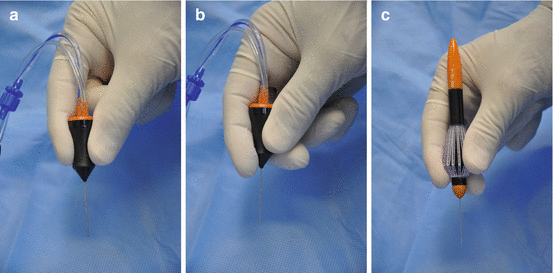(1)
St. Johns, FL, USA
(2)
Helen Keller Foundation for Research and Education, International Society of Ocular Trauma, Birmingham, AL, USA
(3)
Consultant and Vitreoretinal Surgeon, Milos Eye Hospital, Belgrade, Serbia
(4)
Consultant and Vitreoretinal Surgeon, Zagórskiego Eye Hospital, Cracow, Poland
As mentioned before (see Sect. 2.1), the fellow should carefully observe the way the surgeon’s hands and fingers manipulate the instruments he uses. What happens outside the eye explains some of what is happening inside, how external movements relate to internal consequences.
20.1 Holding an Intraocular Instrument1
Holding a device with two fingers is far from ideal under any circumstances.2 Intraocular tools (see Fig. 39.2) but especially intravitreal instruments need to be secured with three fingers (see Fig. 20.1a, b) to prevent any unintentional movement.3
Using a forceps (see Fig. 20.1c and Sect. 13.2.1.3) to perform tasks requiring miniscule movements4 with a very small margin of error requires the greatest possible stability.

Fig. 20.1
Holding the probe. (a) Supporting the probe with only the index finger and the thumb makes it rather unstable, which is risky if fine maneuvers, such as working in the proximity of the retina, are required. (b) By adding the middle finger, the position and movement of the probe are precisely controlled by the surgeon. (c) If a forceps is used, it is even more critical to provide adequate support. Since in this case the surgeon not only holds the tool but must actually squeeze it to enable its function, the use of the supporting middle finger is mandatory
Pearl
There is a reason why chairs have (at least) three legs: they offer stability. Everybody would laugh at a chair with two legs. The same principle applies to holding intraocular tools.
One of the most common mistakes a beginner surgeon makes is to squeeze the tool even when the instrument is simply held, not actively used, or if the tool is a non-squeezable one (e.g., light pipe).5 This is a reflex, probably associated with the high concentration VR surgery demands. However, such squeezing not only offers no benefit, it is potentially detrimental since it increases the magnitude of tremor.
Pearl
The fellow must continually make a conscious effort to not squeeze the instruments unless squeezing is called for and even then to keep the force of squeezing to the minimum (see Sect. 4.1).
Stay updated, free articles. Join our Telegram channel

Full access? Get Clinical Tree


